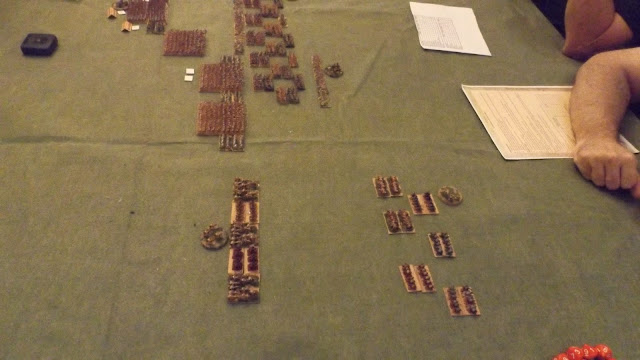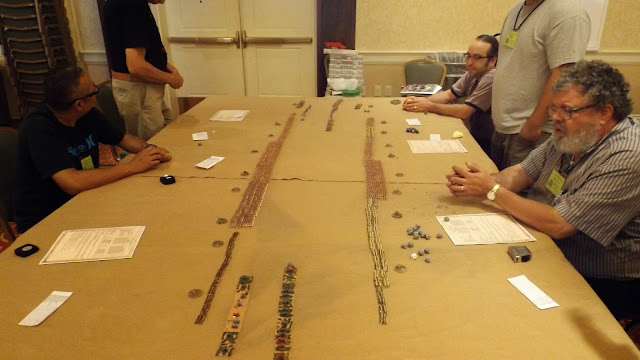Raphia was the first of two battles that I hosted at Pacificon. The rules used were Scutarii from Hoplite Research. There were six players who had never tried the rules before. I would like to thank Mike O'Brien from the Miniature Wargaming Society of Sacramento who came by and assisted with running the game. I was a bit concerned about this battle as there were over 150 units per side and all the players had not seen the rules before. Each unit represented 500 men or 4 elephants. Even though many of the infantry formations were deployed in depth the armies occupied almost ten feet (3 meters) of frontage using 40mm bases. It probably would have been better to have another 2 1/2 foot wide table added to this. Ten feet is slightly over 4.5km wide. Another 2 1/2 feet would increase this to just over 5.6 km. There were 5000 figures used for this battle with about 4000 of them being phalangites. The figures are a mixture of Rapier, Baccus, Irregular, and Heroics and Ros. All the phalangites are from Rapier. The Arabs and Asiatics are from Baccus. Thracians, Gauls, and Lydians from H&R. Elephants and cavalry from all four.
Polybius is the main source for this battle, providing detailed numbers and dispositions for both armies. The Seleucid army had 62,000 infantry, 6000 cavalry, and 102 elephants. Ptolemy had 70,000 infantry, 5000 cavalry, and 73 elephants. There were 35,000 phalangites in the Seleucid army and 61,000 in Ptolemy's army for a total of 96,000 phalangites. The point an combat values for both armies are as below:
| Unit Type | Attack | Defense | Morale | Cost | Ptolemy | Selecucid |
| Guard Cavalry | 5 | 5 | 11 | 11 | 11 | 44 |
| Settler Cavalry | 4 | 5 | 10 | 10 | 50 | 80 |
| Mercenary Cavalry | 3 | 5 | 11 | 10 | 40 | 0 |
| Guard/Mercenary Phalanx | 3 | 6 | 11 | 9 | 234 | 270 |
| Macedonian/Settler Phalanx | 3 | 6 | 10 | 8 | 448 | 320 |
| Egyptian Phalanx | 3 | 6 | 9 | 7 | 280 | 0 |
| Arab/Asiatic Infantry | 3 | 5 | 9 | 5 | 0 | 200 |
| Thracians/Galatians/Lydians | 3 | 5 | 11 | 7 | 84 | 28 |
| Indian Elephants | 4 | 6 | 10 | 13 | 0 | 325 |
| African Elephants | 3 | 6 | 10 | 12 | 216 | 0 |
| | | | | 1363 | 1267 |
Historically, the right wing cavalry of both armies defeated the opposing left wing. Ptolemy left his guard cavalry and moved to the infantry center. Anticochus pursued the opposing cavalry instead of turning on their center. Ptolemy's right wing cavalry did not pursue and turned on the left wing of the Seleucid infantry causing them to flee, this caused all the other Seleucid infantry to rout. The infantry of both armies had held back from contacting the opposing infantry.
The re-fight was to take a slightly different path. The Seleucid right wing defeated their opponents and instead of pursing halted and reformed. Ptolemy had moved to the infantry. On the other wing, Ptolemy's cavalry directly engaged their opposing numbers instead of attempting to skirmish and out flank them. This would result in a drawn out struggle that eventually saw the Seleucid cavalry triumph on the left flank.
In the center both of the infantry lines had held back. Ptolemy's infantry advanced to engage the opposing infantry. The fighting was intense. Part of the left end of the Seleucid infantry broke and fled, but the rest held Eventually part of the Egyptian phalanx broke, the resulting morale checks caused more units to rout. At this point the players on the Ptolemaic side conceded as it was quite likely that most of the rest of the army would fail their morale checks for friends routing and join them.
The following is the basic turn procedure for Scutarii. Both sides dice for initiative with the higher score determining who moves first during a turn. Any troops for the moving side that have to check morale do so before any units are moved. Troops that have missile weapons may use them at any point during their movement and continue to move if they still have movement left. After a side has completed moving, any opposing units in contact will resolve hand-to-hand combat. Units roll a number of dice based on their attack factor, taking into account any modifiers, and must score higher than their opponent's defense value to cause a hit. Hits are cumulative and are not removed. These will cause a unit's morale to decline and represent fatigue, casualties, and loss of fighting spirit.
The following pictures are from the battle. Unfortunately, I had left the container with the hit markers at home and had to resort to some sticky labels to keep track of the hits. Fortunately Mike O'Brin found some blank counters at one of the dealers and these were used to replace the sticky labels. The battle started just after 9 and finished shortly after noon.
Start of battle as viewed from Ptolemy's right/Seleucid left.
Seleucid cavalry advance. Bob Burke commanding left flank of Seleucid army. Ed Gonsalves commanding Ptolemaic center.
The elephants and cavalry engage in combat on that flank.
Cavalry and elephants on the other flank
Combat continues on Bob's flank
view of the center of the battle from behind the Ptolemaic lines
Cavalry and elephant action continues on Bob's flank
view from behind the Seleucid lines
Antiochus defeats the opposing cavalry and prepares to move on Ptolemy's infantry flank.
End of the battle as Ptolemy's phalanx starts to collapse



























































